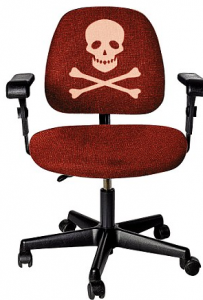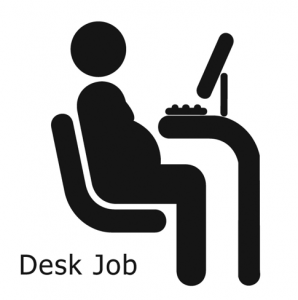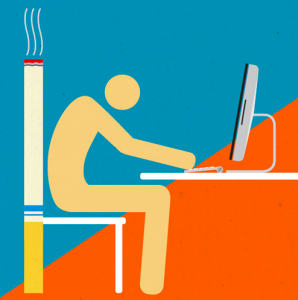20 Jan Are you sitting too much? Ari Whitten and Natalie Jill VIDEO
Are you sitting too much?
You may be surprised to learn that sitting can be just as bad for you as smoking and that your desk job may be making you unhealthy…
You may be surprise to learn that SITTING can be just as damaging to your health as “smoking” and can even sabotage your fat loss efforts. Watch my recent interview below with my good friend Ari Whitten
Can sitting be as bad for you as smoking? Why your desk job may be making you killing you and sabotaging your fat loss efforts at the same time…
This information is below is written by #1 best-selling author Ari Whitten.
Ari is the best selling author of Forever Fat Loss and the creator of cutting-edge program The Energy Blueprint. (By the way, he’s got an incredible FREE training on how to increase your energy levels. It’s a MUST WATCH for anyone who cares about being healthy, increase their energy or wants to lose fat. You can sign up for that 100% FREE Virtual Training HERE.) Ari’s website The Energy Blueprint, which is all about the science of overcoming fatigue and increasing your energy, is www.theenergyblueprint.com
*NOTE: Before reading on it is important to note that this article does not claim to be a treatment or cure for any disease. If you have a serious medical condition, see your doctor and take appropriate action.
In Ari Whitten’s Words…
Your Desk Job is Slowly Killing You and May be making You Fat.
To be blunt: You need to get off your butt, stand up, and MOVE! Not just 3 or 4 times a week at the gym. Not just 45 minutes a day. Not just an hour a day.
If you want optimal health, amazing energy levels, a fast metabolism, and a lean body, you need to be moving (gently) throughout the day, every day!
On the other hand, if you want rapidly degenerating health, chronic fatigue, a slow metabolism, and a fat body, then carry on sitting and not moving for most of the day.
Yes, it really is that big of a deal.
In fact, the amount of time you spend sitting and not moving your muscles is a MORE important factor in fat loss than exercise.
Consider that for a moment. You know how most people out there are constantly fixated on their workout routine–wondering whether they should be doing p90x, or Crossfit, or weight training, or intervals, or cardio or whatever. And virtually all of these people fail to realize that there is actually an EVEN MORE IMPORTANT factor than their workout routine that they’ve given almost ZERO thought to–the amount of gentle movement they’re doing throughout the day.
Yes, it is a bigger factor in how fat or lean you are than your workout routine is. No joke. And we have the science to back this up.
Look, most people just think that if they eat the proper diet and exercise that they will lose weight and be healthy. Diet and exercise. Diet and exercise. If you want to lose weight, everyone just says “it’s all diet and exercise… just eat less and exercise more.”
But it really is NOT THAT SIMPLE!
 Almost everyone out there is overlooking a factor that isn’t nutrition or exercise, and is a huge piece of the fat loss puzzle:
Almost everyone out there is overlooking a factor that isn’t nutrition or exercise, and is a huge piece of the fat loss puzzle:
Non-exercise movement. (a.k.a. Non-exercise activity thermogenesis, or NEAT).
What is NEAT?
It’s basically all the movement of daily living that you do throughout the day just living your life—washing the car, running errands, climbing the stairs, walking down the street to the store, and even things like chewing gum, fidgeting and tapping your feet throughout the day. It is NOT the stuff you do when you go to the gym like do aerobics classes, ride the spin bike, or lift weights. It’s NON-EXERCISE activity.
Dr. James Levine—perhaps the world’s foremost authority on NEAT—says that we now have a major energy crisis occurring. A human energy crisis. What is this crisis all about? Well I’ll let him explain:
“As a doctor who has spent more than twenty years studying human movement, obesity, and metabolism, I can tell you that the way we are living and the way many of us are going about weight loss is absolutely, fundamentally wrong. Fifty years ago, there were no gyms; people rarely ‘exercised,’ and very few people struggled with being overweight. We managed our weight effortlessly because we moved. Now we struggle with it daily because we are desk sentenced.”
NEAT is actually significantly MORE important than our exercise habits when it comes to fat loss, yet virtually no one is talking about it. And it’s not just of critical importance when it comes to fat loss, but also for health, vitality, avoiding diabetes and many other chronic diseases, enhancing energy levels, speeding up our metabolism, and even dramatically prolonging our life.
Here are some of the ways that prolonged sitting affects us:
Prolonged sitting can shorten your lifespan
One study, published in the British Journal of Sports Medicine, which included nearly 12,000 Australian adults, concluded that each hour spent watching television after the age of 25 reduces your life expectancy by nearly 22 minutes. (1) To give you a reference for comparison of something you know is really bad for you, when the authors compared that reduction to smoking, they found that each cigarette reduces your life expectancy only by about 11 minutes.
Prolonged sitting can increase your risk of heart disease, diabetes and cancer
Research now indicates that sitting for  several hours each day is as significant a health risk factor as obesity and smoking. One article published in Diabetologia analyzed 18 studies that in total included nearly 800,000 people, and found that those who sat for the longest periods of time were twice as likely to have diabetes or heart disease compared to those who sat the least.
several hours each day is as significant a health risk factor as obesity and smoking. One article published in Diabetologia analyzed 18 studies that in total included nearly 800,000 people, and found that those who sat for the longest periods of time were twice as likely to have diabetes or heart disease compared to those who sat the least.
Prolonged sitting can disrupt normal appetite regulation and predisposes us to fat gain
Sitting disrupts the body’s normal ability to regulate appetite (calorie intake) in accordance with biological need (i.e. calorie expenditure), and leads to a state of physiology that predisposes to calorie over-consumption, and thus, fat gain. (3)(4)(5)(6)
Prolonged sitting can cause insulin resistance
Sitting induces profound levels of insulin resistance and predisposes to type II diabetes. One single day of sitting can significantly impact insulin sensitivity, and even when calorie intake is intentionally reduced to match the decreased level of activity, we still see insulin resistance. (7)
Prolonged sitting can cause chronic fatigue
Sitting and inactivity can lead to decreased number and health of mitochondria—the cellular energy generators—and thus slow down the metabolism over time. Less mitochondria tends to decrease physical energy levels over time, and predisposes to chronic fatigue. (8) (If you work a desk job, and you struggle with fatigue, you should have a light bulb going off in your head right now).
Prolonged sitting can shut down fat burning
When you sit, your muscles go flaccid. And when your muscles go flaccid, the enzyme LPL (lipoprotein lipase)–which is critical to fat burning–shuts down by 95%. In other words, when you are sitting, there is virtually no fat burning happening in your body. (9)
Prolonged sitting can erase the metabolic benefits of exercise
New research shows that every hour that you sit erases between 8-16% of the metabolic benefits of your workouts! (10) If that is not mind blowing to you, then you really need to think more deeply about what that really means. Do the math here! That means that even if you do an hour long workout 7 days a week, if you SIT for 10 hours a day, then you’ve just erased AT LEAST 80% of the metabolic benefits of that workout, and maybe well over 100%. One step forward, one step back. This is a recipe for working out hard and still spinning your wheels getting nowhere.
 If you typically sit most of the day, well now you know why you’re chronically low in energy, and why you’re struggling to lose fat despite eating well and working out hard.
If you typically sit most of the day, well now you know why you’re chronically low in energy, and why you’re struggling to lose fat despite eating well and working out hard.
Watch the video above to see how to start getting your NEAT habits dialed in for optimal health, energy, and fat loss.
Are you ready to take your body and energy to the next level?
Ari has put together what may just be the most advanced and cutting-edge, science-packed health program in the world. It’s called The Energy Blueprint and people are absolutely raving about it. He offers an amazing “Overcome Fatigue and Double Your Energy” FREE Virtual Training course that is a MUST WATCH for anyone who cares about their health and wants more energy. You can sign up for that HERE.
___________________________
Ari’s website is www.theenergyblueprint.com
If you’re looking to improve your body and your energy levels, make sure to sign up for Ari’s incredible FREE “Double Your Energy” Video Training course HERE.
_______________________________________
References:
1. Veerman, J. L., Healy, G. N., Cobiac, L. J., Vos, T., Winkler, E. A. H., Owen, N., & Dunstan, D. W. (2012).
Television viewing time and reduced life expectancy: a life table analysis. Br J Sports Med. 46, 927-930
doi:10.1136/bjsports-2011-085662
2. Wilmot, E. G., Edwardson, C. L., Achana, F. A., Davies, M. J., Gorely, T., Gray, L. J., … Biddle, J. H. (2012).
Sedentary time in adults and the association with diabetes, cardiovascular disease and death: systematic
review and meta-analysis. Diabetologia. 55(11), 2895-2905
3. Latouche et al. Effects of breaking up prolonged sitting on skeletal muscle gene expression. Vol. 114no. 4, 453-460. http://jap.physiology.org/content/114/4/453
4. Granados K, et al. Appetite regulation in response to sitting and energy imbalance. Appl Physiol Nutr Metab. 2012 Apr;37(2):323-33. http://www.ncbi.nlm.nih.gov/pubmed/22462636
5. Blundell JE1, et al. Cross talk between physical activity and appetite control: does physical activity stimulate appetite? Proc Nutr Soc. 2003 Aug;62(3):651-61. http://www.ncbi.nlm.nih.gov/pubmed/14692601
6. Why sitting is the best way to work up an appetite. http://www.dailymail.co.uk/health/article-1061462/Why-sitting-best-way-work-appetite.html
7. Pedersen BK. The diseasome of physical inactivity–and the role of myokines in muscle–fat cross talk. J Physiol. 2009 Dec 1;587(Pt 23):5559-68. doi: 10.1113/jphysiol.2009.179515
8. Low-intensity Exercise Reduces Fatigue Symptoms By 65 Percent, Study Finds http://www.sciencedaily.com/releases/2008/02/080228112008.htm
9. Bey, L. and M.T. Hamilton, Suppression of skeletal muscle lipoprotein lipase activity during physical inactivity: a molecular reason to maintain daily low-intensity activity. J Physiol, 2003. 551(Pt 2): p. 673-82.
10. Kulinski et al. Association Between Cardiorespiratory Fitness and Accelerometer-Derived Physical Activity and Sedentary Time in the General Population. Mayo Clinic Proceedings.

